The first of its kind in the world, founded in Compiègne in 1927, the National Car and Tourism Museum waits while a large-scale project combining aesthetic, societal and future mobility aspects lies in the hands of the French State. We take a look at what is at stake.
Polluting, useful but valueless, dangerous... Is the disillusionment with the car today jeopardizing our knowledge of it? As you walk through the National Car and Tourism Museum, which has been housed in the neoclassical Chateau de Compiègne for almost a century, the answer seems obvious. An outmoded museography, yellowing paintings, inaccessible collections, piled up vehicles, minimal or no mediation: the ever-shrinking pathway with rooms gradually closed and converted into storage rooms is troubling. Worse still, the large kitchen courtyard, covered in the 1930s with a magnificent glass roof by architect Marc Bitterlin (1885-1963)—a pupil of Gaston Redon ( Odilon's brother)—only received the waterproofing and safety work necessary for its reopening in 2019 after 20 years out of action. But the opaque whitewash concealing the structure is still there. Origins In the land where the motor vehicle was invented, the idea of a museum retracing the history of road locomotion from the early days of horse-drawn carriages to the emergence of the automobile and tourism arose under the most promising…
com.dsi.gazette.Article : 33041
This article is for subscribers only
You still have 85% left to read.
